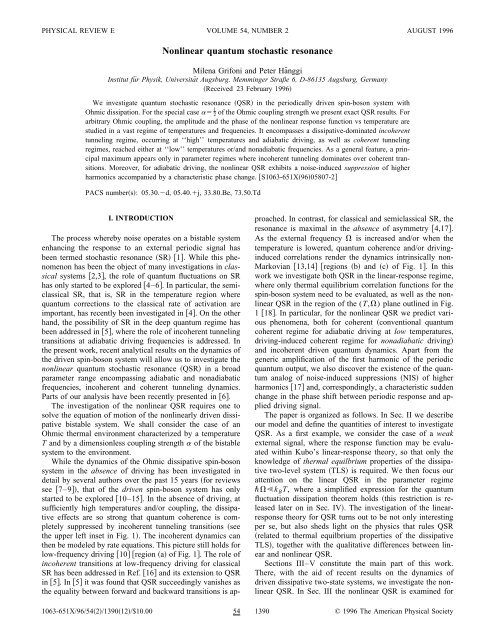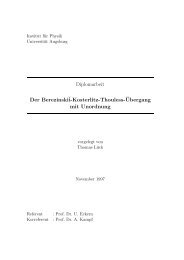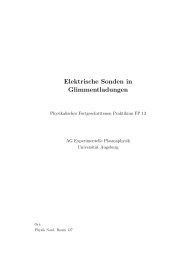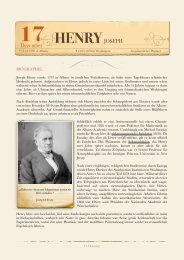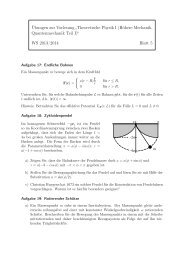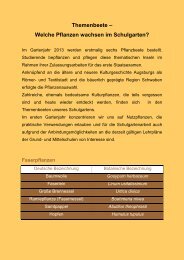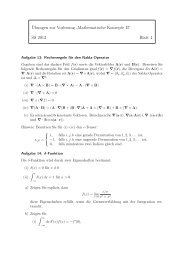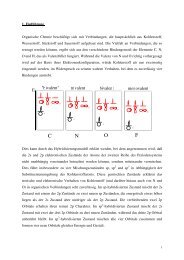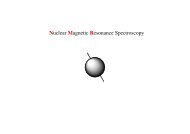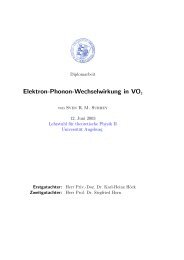Nonlinear quantum stochastic resonance - Institut für Physik ...
Nonlinear quantum stochastic resonance - Institut für Physik ...
Nonlinear quantum stochastic resonance - Institut für Physik ...
- No tags were found...
Create successful ePaper yourself
Turn your PDF publications into a flip-book with our unique Google optimized e-Paper software.
PHYSICAL REVIEW E VOLUME 54, NUMBER 2<br />
AUGUST 1996<br />
<strong>Nonlinear</strong> <strong>quantum</strong> <strong>stochastic</strong> <strong>resonance</strong><br />
Milena Grifoni and Peter Hänggi<br />
<strong>Institut</strong> <strong>für</strong> <strong>Physik</strong>, Universität Augsburg, Memminger Straße 6, D-86135 Augsburg, Germany<br />
Received 23 February 1996<br />
We investigate <strong>quantum</strong> <strong>stochastic</strong> <strong>resonance</strong> QSR in the periodically driven spin-boson system with<br />
Ohmic dissipation. For the special case 1 2 of the Ohmic coupling strength we present exact QSR results. For<br />
arbitrary Ohmic coupling, the amplitude and the phase of the nonlinear response function vs temperature are<br />
studied in a vast regime of temperatures and frequencies. It encompasses a dissipative-dominated incoherent<br />
tunneling regime, occurring at ‘‘high’’ temperatures and adiabatic driving, as well as coherent tunneling<br />
regimes, reached either at ‘‘low’’ temperatures or/and nonadiabatic frequencies. As a general feature, a principal<br />
maximum appears only in parameter regimes where incoherent tunneling dominates over coherent transitions.<br />
Moreover, for adiabatic driving, the nonlinear QSR exhibits a noise-induced suppression of higher<br />
harmonics accompanied by a characteristic phase change. S1063-651X9605807-2<br />
PACS numbers: 05.30.d, 05.40.j, 33.80.Be, 73.50.Td<br />
I. INTRODUCTION<br />
The process whereby noise operates on a bistable system<br />
enhancing the response to an external periodic signal has<br />
been termed <strong>stochastic</strong> <strong>resonance</strong> SR 1. While this phenomenon<br />
has been the object of many investigations in classical<br />
systems 2,3, the role of <strong>quantum</strong> fluctuations on SR<br />
has only started to be explored 4–6. In particular, the semiclassical<br />
SR, that is, SR in the temperature region where<br />
<strong>quantum</strong> corrections to the classical rate of activation are<br />
important, has recently been investigated in 4. On the other<br />
hand, the possibility of SR in the deep <strong>quantum</strong> regime has<br />
been addressed in 5, where the role of incoherent tunneling<br />
transitions at adiabatic driving frequencies is addressed. In<br />
the present work, recent analytical results on the dynamics of<br />
the driven spin-boson system will allow us to investigate the<br />
nonlinear <strong>quantum</strong> <strong>stochastic</strong> <strong>resonance</strong> QSR in a broad<br />
parameter range encompassing adiabatic and nonadiabatic<br />
frequencies, incoherent and coherent tunneling dynamics.<br />
Parts of our analysis have been recently presented in 6.<br />
The investigation of the nonlinear QSR requires one to<br />
solve the equation of motion of the nonlinearly driven dissipative<br />
bistable system. We shall consider the case of an<br />
Ohmic thermal environment characterized by a temperature<br />
T and by a dimensionless coupling strength of the bistable<br />
system to the environment.<br />
While the dynamics of the Ohmic dissipative spin-boson<br />
system in the absence of driving has been investigated in<br />
detail by several authors over the past 15 years for reviews<br />
see 7–9, that of the driven spin-boson system has only<br />
started to be explored 10–15. In the absence of driving, at<br />
sufficiently high temperatures and/or coupling, the dissipative<br />
effects are so strong that <strong>quantum</strong> coherence is completely<br />
suppressed by incoherent tunneling transitions see<br />
the upper left inset in Fig. 1. The incoherent dynamics can<br />
then be modeled by rate equations. This picture still holds for<br />
low-frequency driving 10 region a of Fig. 1. The role of<br />
incoherent transitions at low-frequency driving for classical<br />
SR has been addressed in Ref. 16 and its extension to QSR<br />
in 5. In5it was found that QSR succeedingly vanishes as<br />
the equality between forward and backward transitions is approached.<br />
In contrast, for classical and semiclassical SR, the<br />
<strong>resonance</strong> is maximal in the absence of asymmetry 4,17.<br />
As the external frequency is increased and/or when the<br />
temperature is lowered, <strong>quantum</strong> coherence and/or drivinginduced<br />
correlations render the dynamics intrinsically non-<br />
Markovian 13,14 regions b and c of Fig. 1. In this<br />
work we investigate both QSR in the linear-response regime,<br />
where only thermal equilibrium correlation functions for the<br />
spin-boson system need to be evaluated, as well as the nonlinear<br />
QSR in the region of the (T,) plane outlined in Fig.<br />
1 18. In particular, for the nonlinear QSR we predict various<br />
phenomena, both for coherent conventional <strong>quantum</strong><br />
coherent regime for adiabatic driving at low temperatures,<br />
driving-induced coherent regime for nonadiabatic driving<br />
and incoherent driven <strong>quantum</strong> dynamics. Apart from the<br />
generic amplification of the first harmonic of the periodic<br />
<strong>quantum</strong> output, we also discover the existence of the <strong>quantum</strong><br />
analog of noise-induced suppressions NIS of higher<br />
harmonics 17 and, correspondingly, a characteristic sudden<br />
change in the phase shift between periodic response and applied<br />
driving signal.<br />
The paper is organized as follows. In Sec. II we describe<br />
our model and define the quantities of interest to investigate<br />
QSR. As a first example, we consider the case of a weak<br />
external signal, where the response function may be evaluated<br />
within Kubo’s linear-response theory, so that only the<br />
knowledge of thermal equilbrium properties of the dissipative<br />
two-level system TLS is required. We then focus our<br />
attention on the linear QSR in the parameter regime<br />
k B T, where a simplified expression for the <strong>quantum</strong><br />
fluctuation dissipation theorem holds this restriction is released<br />
later on in Sec. IV. The investigation of the linearresponse<br />
theory for QSR turns out to be not only interesting<br />
per se, but also sheds light on the physics that rules QSR<br />
related to thermal equilbrium properties of the dissipative<br />
TLS, together with the qualitative differences between linear<br />
and nonlinear QSR.<br />
Sections III–V constitute the main part of this work.<br />
There, with the aid of recent results on the dynamics of<br />
driven dissipative two-state systems, we investigate the nonlinear<br />
QSR. In Sec. III the nonlinear QSR is examined for<br />
1063-651X/96/542/139012/$10.00 54 1390 © 1996 The American Physical Society
54 NONLINEAR QUANTUM STOCHASTIC RESONANCE<br />
1391<br />
FIG. 1. Dynamics of the<br />
driven (ˆ 0) two-state system<br />
for weak Ohmic coupling . As<br />
the temperature T or frequency<br />
is varied in the (T,) plane,<br />
different tunneling regimes are encountered.<br />
For strong coupling,<br />
regimes a and b extend down<br />
to the lowest temperatures. For<br />
comparison, the static case<br />
(ˆ 0) is considered in the inset,<br />
where the parameter regions in the<br />
(,T) plane for incoherent or<br />
<strong>quantum</strong> coherent QC tunneling<br />
are drawn.<br />
the case 1/2 of the Ohmic coupling strength. Therein, we<br />
obtain exact QSR results. In Sec. IV an iterative scheme is<br />
discussed that allows the evaluation of the nonlinear response<br />
function, within the non-interacting-blip approximation<br />
NIBA for the <strong>stochastic</strong> forces, for any driving<br />
strength and frequency. As a first application, we consider<br />
the linear-response limit of our results and within the NIBA<br />
we evaluate the linear susceptibility for any driving frequency<br />
. Second, we release the assumption of weak driving<br />
strengths and investigate the nonlinear QSR in the regimes<br />
of adiabatic driving where within the NIBA the<br />
dynamics is Markovian and of nonadiabatic driving where a<br />
driving-induced coherence occurs. In Sec. V we study the<br />
nonlinear QSR in the regime of weak coupling and low temperatures<br />
where coherent tunneling occurs and the NIBA<br />
fails. In doing so we use the results of a golden rule approach<br />
to the TLS dynamics. Finally, in Sec. VI we present<br />
our conclusions.<br />
II. THE BISTABLE MODEL FOR SR<br />
As a working model we consider a TLS Hamiltonian.<br />
Here the bath is described as an ensemble of harmonic oscillators<br />
with a bilinear coupling in the TLS bath coordinates<br />
and we allow for an externally applied harmonic force<br />
(ˆ /a)cost, of amplitude ˆ/a and frequency . Then, the<br />
driven spin-boson Hamiltonian reads<br />
H 2 x 0 z ˆ<br />
1 2 <br />
<br />
2 cost z<br />
p 2<br />
m <br />
m 2 x 2 c x a z .<br />
2.1<br />
The ’s are Pauli matrices and the eigenstates of z are the<br />
basis states in a localized representation, while a is the tunneling<br />
distance. The tunneling splitting energy of the symmetric<br />
TLS is given by , while the asymmetry energy is<br />
0 . Finally, the dissipative influence of the bath is fully<br />
characterized by a zero average (t) 0 0 and by the correlation<br />
function<br />
t0 0 <br />
0<br />
<br />
dJ<br />
cosh/2it<br />
sinh/2<br />
2.2<br />
of the <strong>stochastic</strong> force c x 7,8. Here 1/k B T is<br />
the inverse of the temperature and 0 denotes the ensemble<br />
average with respect to the bath Hamiltonian with all the<br />
coupling constants c set to zero. J() is the spectral density<br />
of the environment and we make the specific choice of<br />
Ohmic dissipation J()(2/a 2 )e / c, where is<br />
the dimensionless coupling strength and c is a cutoff frequency<br />
7–9. In the following we shall assume that the cutoff<br />
frequency c in the environment modes is the highest<br />
frequency of the problem.<br />
Finally, the dynamical quantity P(t) z (t) is considered<br />
to be the output of the system to the external perturbation<br />
and the averaged power spectrum S¯()<br />
<br />
S¯ de i C¯,<br />
<br />
2.3<br />
defined as the Fourier transform of the averaged correlation<br />
function C¯()<br />
C¯ 2<br />
0<br />
2/<br />
dt<br />
1<br />
2 zt z t z t z t,<br />
2.4<br />
is the quantity of interest to investigate SR 20. The combined<br />
influence of dissipative and driving forces at intermediate<br />
times results in a reduction of the coherent tunneling<br />
motion of the isolated TLS by incoherent tunneling transitions.<br />
For times t large compared to the time scale of the<br />
transient dynamics, the motion acquires the periodicity of the<br />
external perturbation and P(t) and C¯() reach the asymptotic<br />
values
1392 MILENA GRIFONI AND PETER HANGGI<br />
54<br />
and<br />
lim PtP t→<br />
ast <br />
<br />
m<br />
P m ,ˆe imt<br />
<br />
<br />
m<br />
P m ,ˆe imt m <br />
2.5<br />
(ˆ 0). Hence, from the definitions of Eq. 2.8, the study of<br />
the power amplitude 1 or of the phase 1 reduces to the<br />
evaluation of the linear susceptibility, yielding<br />
1 4˜ 2 ,<br />
2.10<br />
lim C¯C → as <br />
<br />
m<br />
P m ,ˆ 2 e im .<br />
2.6<br />
The harmonics P m of P(t) present the quantity of interest to<br />
investigate the nonlinear QSR. The amplitudes P m determine<br />
the weights of the spikes of the averaged spectral<br />
power density in the asymptotic state S as () via the relation<br />
6,19<br />
<br />
S as 2<br />
m<br />
P m ,ˆ 2 m.<br />
2.7<br />
In order to investigate QSR we shall examine the scaled<br />
power amplitude m in the mth frequency component of<br />
S as () and the associated phase shift m as well, i.e.,<br />
m ,ˆ 4P m ,ˆ /ˆ 2 ,<br />
m ,ˆ arctan ImP m,ˆ <br />
ReP m ,ˆ .<br />
2.8<br />
As a final remark we observe that, for weak external signals,<br />
only the fundamental power amplitude 1 and phase shift<br />
1 are different from zero to linear order in the external<br />
strength. Within such an approximation, these quantities are<br />
related to the amplitude and phase of the linear susceptibility,<br />
respectively. Hence they can be also evaluated by computing<br />
correlation functions at thermal equilibrium. The results<br />
of this procedure are discussed in the following<br />
subsection for the case of slow driving fields 1.<br />
For strong driving forces, the linear-response approximation<br />
breaks down and the evaluation of 1 and 1 , or of<br />
higher harmonics, involves the computation of statistical<br />
quantities of the full Hamiltonian 2.1. As we shall see, in<br />
the nonlinear regime strong nonlinear effects such as a noiseinduced<br />
suppression of higher-order harmonics may appear.<br />
Linear response for QSR<br />
For weak external signals, P as (t) can be evaluated within<br />
the linear-response approximation. Then, only the harmonics<br />
0,1 ofP as (t) in Eq. 2.5 are different from zero. In particular,<br />
P 0 becomes just the thermal equilibrium value P eq of<br />
the operator z in the absence of driving and<br />
P 1 ˆ ˜() is related by Kubo’s formula 21 to the<br />
linear susceptiblility ˜qq ()a 2 ˜() for the particle position<br />
qa/2 z , where<br />
˜qq i <br />
de i q,q0<br />
.<br />
<br />
2.9<br />
Here () is the Heaviside function and , denotes the commutator<br />
and the thermal statistical average of the full<br />
system in the absence of the external periodic force<br />
1 arctan Im˜<br />
Re˜<br />
.<br />
2.11<br />
Further, the absorptive part Im˜() of the susceptibility is<br />
related to the Fourier transform C˜() of the symmetrized<br />
correlation function C()C qq ()/a 2 , where C qq ()<br />
1 2q(t)q(t)q(t)q(t) , by the fluctuation dissipation<br />
theorem 22<br />
Im˜tanh/2C˜.<br />
2.12<br />
The real part Re˜() follows from Eq. 2.12 through the<br />
Kramers-Kronig relations. Hence the study of the linear SR,<br />
within an approach based on Kubo’s theory, involves the<br />
evaluation of correlation functions in thermal equilibrium.<br />
The computation of the symmetrized correlation function<br />
C˜() can be carried out approximately 7,8,23,24. Aswe<br />
shall see, an investigation of the linear response for QSR will<br />
be fundamental to understand some general characteristics of<br />
QSR, together with the qualitative differences between the<br />
linear and nonlinear QSR.<br />
Let us first consider the case of weak coupling 1,<br />
which exhibits the richest behavior as the temperature is varied.<br />
At low temperatures the tunneling dynamics is dominated<br />
by <strong>quantum</strong> coherent effects even in the presence of<br />
dissipation see the inset in Fig. 1, where QC denotes the<br />
parameter region in the (,T) plane where <strong>quantum</strong> coherence<br />
occurs 7–9. To be definite, at low temperatures<br />
k B TE/2 where E :( 2 e 2 0 ) 1/2 denotes the bath<br />
renormalized energy difference between the two energy levels<br />
and e () the renormalized tunneling splitting and<br />
weak coupling, the two-level system undergoes damped coherent<br />
oscillations of frequency E/ and lifetime coh . Superimposed<br />
to this is an incoherent tunneling motion with<br />
decay time rel towards the thermal equilibrium value<br />
P eq 0 /E tanh(E/2k B T). The corresponding symmetrized<br />
correlation function C˜() has been evaluated in 23. Itexhibits<br />
two narrow <strong>resonance</strong>s of width coh around<br />
E/ related to the damped coherent oscillations of the<br />
TLS, and a quasielastic peak of width rel at 0, describing<br />
incoherent relaxation towards thermal equilibrium.<br />
Within a Lorentzian approximation valid at 1, the<br />
linear susceptibility ˜() is readily obtained by use of the<br />
fluctuation dissipation theorem Eq. 2.12 and reads<br />
where<br />
˜˜coh ˜rel ,<br />
2.13
54 NONLINEAR QUANTUM STOCHASTIC RESONANCE<br />
1393<br />
FIG. 2. Amplification vs temperature<br />
of the fundamental amplitude<br />
1 for weak signals in the<br />
region of <strong>quantum</strong> coherent tunneling<br />
full line. Because the coherent<br />
contribution 2.14 to 1<br />
decreases monotonically dashed<br />
line, the QSR maximum arises<br />
solely because of incoherent transitions.<br />
Here and in the following<br />
figures, frequencies are in units of<br />
e and temperatures in units of<br />
e /k B .<br />
˜coh 2<br />
e<br />
4E 2 tanh<br />
E<br />
2k B T<br />
<br />
1<br />
E/i coh 1<br />
E/i coh <br />
˜rel 2<br />
0 1<br />
E<br />
<br />
4k B T<br />
1<br />
,<br />
2.14<br />
cosh 2 E/2k B T 1i rel<br />
2.15<br />
1<br />
1 ,<br />
and the dissipation renormalized tunneling matrix e is<br />
e c /1 cos12 1/22 .<br />
2.16<br />
Finally, the rates coh and rel are given by<br />
rel e<br />
E<br />
<br />
2 E<br />
coth<br />
E<br />
2k B T ,<br />
coh rel<br />
2<br />
2 0<br />
E<br />
<br />
2 k B T<br />
.<br />
2.17<br />
2.18<br />
Hence the linear susceptibility ˜() is the sum of a coherent<br />
and of an incoherent contribution, the former being the only<br />
one that survives as T→0. From Eqs. 2.10–2.15 the linear<br />
QSR can now be straightforwardly investigated. In Fig. 2<br />
the power amplitude 1 in 2.10, i.e., the squared amplitude<br />
of the linear susceptibility ˜, is plotted versus temperature in<br />
the parameter region where <strong>quantum</strong> coherence occurs solid<br />
line. The frequencies are expressed in units of e and the<br />
temperature is given in units of e /k B . Because the coherent<br />
contribution 2.14 decreases monotonically with temperature<br />
see the dashed line, we find the intriguing result<br />
that the maximum for QSR arises because of the incoherent<br />
relaxational dynamics of an asymmetric TLS towards thermal<br />
equilibrium with 0 0, one has ˜rel 0 for a symmetric<br />
TLS. Finally, the QSR maximum in 1 , obtained by combining<br />
Eq. 2.10 with Eqs. 2.14 and 2.15, is attained<br />
roughly when Ek B T. Because of the smooth temperature<br />
dependence of the relaxation rate rel , the maximum is determined<br />
by the competition between the detailed balance<br />
factor 1/cosh 2 (E/2k B T) which saturates to the value 1 when<br />
2k B TE) and the algebraic factor T 1 stemming from<br />
˜rel () in Eq. 2.15.<br />
As the temperature is increased dissipation-induced incoherent<br />
tunneling transitions become increasingly important,<br />
until the coherent tunneling motion is destroyed above the<br />
temperature T*()E/2k B 23. Correspondingly, the<br />
three peaks of 2.15 merge into a single quasielastic peak of<br />
width ,<br />
˜<br />
1<br />
4k B T<br />
1<br />
cosh 2 0 /2k B T<br />
1<br />
1i <br />
1 .<br />
2.19<br />
On the other hand, for strong coupling 1/2 incoherent<br />
transitions always dominate the dynamics at any temperature.<br />
This parameter regime is sketched in the upper left inset<br />
of Fig. 1 incoherent tunneling. Hence, at high temperatures<br />
TT*() for weak coupling, as well as always for strong<br />
coupling, the dynamics can be described in terms of a Markovian<br />
rate equation for the position’s probability<br />
Ṗt PtP eq ,<br />
2.20<br />
with rate and towards the equilibrium value<br />
P eq tanh( 0 /2k B T). When 1 or/and when TT* one<br />
finds that Re ( 0 ) and P eq tan()Im( 0 )/<br />
Re( 0 )tanh( 0 /2k B T). Here<br />
0 e<br />
<br />
e<br />
12<br />
2<br />
<br />
i 0 /2<br />
1i 0 /2<br />
2.21<br />
and (z) denotes the gamma function. Again, from an analysis<br />
of Eq. 2.19 the linear QSR in the regime of incoherent<br />
tunneling can be investigated. Similar to the previously discussed<br />
QC case, the QSR maximum is attained roughly<br />
when 0 k B T. The QSR is determined by the competition<br />
between the detailed balance factor 1/cosh 2 ( 0 /2k B T),<br />
which exponentially increases with the temperature until it<br />
saturates to the value 1 when 2k B T 0 , and the algebraic
1394 MILENA GRIFONI AND PETER HANGGI<br />
54<br />
FIG. 3. Amplification vs temperature<br />
of the fundamental amplitude<br />
1 cf. 2.8 via <strong>quantum</strong><br />
SR, for different driving strengths<br />
ˆ in the exactly solvable case<br />
1/2 of the Ohmic strength.<br />
The principal maximum occurs in<br />
the temperature region where incoherent<br />
tunneling prevails see<br />
Fig. 4.<br />
factor T 1 in the incoherent susceptibility 5. For a quasisymmetric<br />
system 0 k B T the saturation is immediately<br />
attained and the linear susceptibility shows only a monotonic<br />
decay as the temperature is increased; hence no SR peak<br />
occurs.<br />
h 2k ,1 k sin<br />
0<br />
<br />
de<br />
/2S<br />
e ik sin 0 J 2k 2ˆ<br />
sin 2<br />
,<br />
III. AN EXACT SOLUTION FOR THE NONLINEAR QSR:<br />
THE CASE 1/2<br />
The main theme of the periodically driven spin-boson system<br />
is the modification of the coherent tunneling motion of<br />
the isolated TLS by the combined influence of the environmental<br />
and driving forces. As discussed in the preceding<br />
section, the environmental <strong>stochastic</strong> forces act in reducing<br />
the transient coherent tunneling by incoherent processes until,<br />
at long times, <strong>quantum</strong> coherence is completely suppressed.<br />
For driven systems the asymptotic dynamics acquires<br />
the periodicity of the periodic force, independently of<br />
the characteristics of the thermal bath. An exact formal solution<br />
for any strength of the external force, which is in the<br />
form of a power series in the tunneling transitions, has been<br />
obtained using a real-time path-integral approach in<br />
10,13,14. For arbitrary coupling one has to resort to approximate<br />
solutions of the formal solution. In Secs. IV and V<br />
we shall discuss controlled approximations that cover the<br />
entire range of parameters outlined in Fig. 1. In this section<br />
we shall consider the special value 1/2 of the Ohmic<br />
friction. In contrast to the classical case, where no exact<br />
closed analytical solutions are yet available for the nonlinear<br />
dynamics, in the <strong>quantum</strong> case the two-state approximation<br />
of the dynamics within an extended bistable potential allows<br />
an exact solution for this special value of the Ohmic strength.<br />
As shown in 10, the power series in the tunneling transitions<br />
can be summed up exactly in analytic form to give<br />
h 2k1 ,1 k sin<br />
0<br />
<br />
de<br />
/2S<br />
e ik1/2 cos 0 J 2k1 2ˆ<br />
sin 2<br />
.<br />
3.2<br />
Here S()2ln c /sinh(/), J m (z) is a Bessel<br />
function of the first kind, and 2 /2 c is the dissipation<br />
renormalized tunneling frequency e see Eq. 2.16 for<br />
1/2. In Fig. 3 the power amplitude 1 (,ˆ ) is plotted as<br />
a function of the temperature for different driving strengths<br />
ˆ frequencies are in units of and temperatures in units of<br />
/k B ). Following the discussion of Sec. II, 1 can be interpreted<br />
as the squared amplitude of a generalized nonlinear<br />
susceptibility NL (,ˆ ). For highly nonlinear driving fields<br />
ˆ 0 the power amplitude decreases monotonically as the<br />
temperature increases uppermost curve. As the driving<br />
strength for periodic driving ˆ is decreased, a shallow minimum<br />
followed by a maximum appears when the static asymmetry<br />
0 equals, or slightly overcomes, both the external<br />
frequency and strength ˆ intermediate curves. For even<br />
smaller external amplitudes, the nonlinear QSR can be studied<br />
within the linear-response theory dashed curve, where<br />
the linear susceptibility for the special case 1/2 takes the<br />
analytic form<br />
<br />
P m ,ˆ <br />
im<br />
2 c<br />
h mim,,<br />
3.1<br />
˜<br />
1<br />
2i<br />
<br />
i<br />
<br />
,<br />
3.3<br />
with<br />
with
54 NONLINEAR QUANTUM STOCHASTIC RESONANCE<br />
1395<br />
x <br />
x i <br />
2<br />
x <br />
x i <br />
2<br />
,<br />
3.4<br />
g 2k 1 k 2 cos<br />
0<br />
<br />
de<br />
S<br />
e ik cos 0 J 2k 2ˆ<br />
sin 2<br />
,<br />
and x 1 2 /2 (/2i 0 ). In the linear region the<br />
shallow minimum is washed out and only the principal maximum<br />
survives. It is now interesting to observe that, because<br />
for the undriven case the TLS dynamics for 1/2 is always<br />
incoherent down to T0, again the principal maximum<br />
arises at the temperature T at which the relaxation process<br />
towards thermal equilibrium is maximal. On the other hand,<br />
the minimum in 1 appears in the temperature region where<br />
driving-induced coherent processes are of importance. This<br />
means that the power amplitude 1 or the nonlinear susceptibility<br />
NL (,ˆ ) plotted versus frequency shows <strong>resonance</strong>s<br />
when 0 /n (n1,2,...) full line in Fig. 4.<br />
This is a typical nonlinear effect, which has to be compared<br />
with the <strong>resonance</strong>s at E that the coherent part 2.14<br />
of the linear susceptibility exhibits in the <strong>quantum</strong> coherent<br />
regime. Correspondingly, the dynamics is intrinsically non-<br />
Markovian. As the temperature is increased, the coherence is<br />
increasingly lost note the behavior of the dot-dashed and<br />
dashed lines in Fig. 4.<br />
g 2k1 1 k1 2 cos<br />
0<br />
<br />
de<br />
S<br />
e ik1/2 sin 0 J 2k1 2ˆ<br />
sin 2<br />
.<br />
4.3<br />
We now observe that the coupled ensemble of equations<br />
4.2 can be converted again into the integro-differential<br />
equation<br />
Ṗ as tFt 2<br />
0<br />
2/<br />
dtPas tLt,tt<br />
that describes the time evolution within a period. Here<br />
Ft<br />
n<br />
e int f n in,<br />
4.4<br />
IV. INCOHERENT AND COHERENT QSR WITHIN THE<br />
NIBA<br />
Lt,t<br />
m,n<br />
e imt e int g m in.<br />
4.5<br />
In the static case (ˆ 0), the major difficulty for an analytic<br />
resummation of the series in the TLS tunneling transitions<br />
arises from the bath-induced correlations between different<br />
transitions. Further, it is known that a perturbative<br />
approach in the Ohmic coupling would fail in describing the<br />
destruction of the <strong>quantum</strong> coherent motion induced by the<br />
environmental <strong>stochastic</strong> forces at finite temperatures. In the<br />
presence of time-dependent driving the situation is even<br />
more intricate, because one also has to take into account the<br />
correlations induced by the external field. The bath-induced<br />
correlations can be treated within the non-interacting-blip approximation<br />
for the <strong>stochastic</strong> force 10,13, whose range of<br />
validity is, in general, different as compared to the undriven<br />
case, and it has to be determined self-consistently. A set of<br />
coupled equations for the Fourier coefficients P m has been<br />
recently derived for any strength and frequency of the driving<br />
force 13, yielding the result<br />
and for m0<br />
P 0 f 00<br />
g 0 0 <br />
m0<br />
g m 0<br />
g 0 0 P m ,<br />
P m i<br />
m f mim<br />
m<br />
4.1<br />
g mm imP m . 4.2<br />
This result, within the NIBA, is still exact and explicitly<br />
shows that, even at high temperatures and/or strong coupling,<br />
the asymptotic driven dynamics is intrinsically non-<br />
Markovian in contrast to Eq. 2.20 for the undriven case.<br />
In the following we shall first briefly discuss the linear response<br />
limit of Eqs. 4.1 and 4.2 valid for any frequency.<br />
Subsequently, we shall release the assumption of weak external<br />
fields and we shall study the nonlinear QSR in the case<br />
of high-frequency and low-frequency driving, respectively,<br />
where two different approximations of Eq. 4.4 are discussed.<br />
For the weak-coupling case and not too low temperatures<br />
so that the NIBA still applies, they would represent<br />
the regions a and b, respectively, of Fig. 1. Region c of<br />
Fig. 1 is investigated in Sec. V. In the strong-coupling case,<br />
only region a or b may be attained, but not region c<br />
because adiabatic <strong>quantum</strong> coherence at strong friction never<br />
occurs.<br />
A. Linear response<br />
On the assumption that the driving force is weak, Eqs.<br />
4.1 and 4.2 can be evaluated by linearizing them in the<br />
amplitude ˆ of the time-dependent force. To linear order in<br />
ˆ , only the coefficients f m and g m with m0,1 need to be<br />
considered. Further, the linearized coefficients f (0) 0 ,g (0) 0 are<br />
of order zero in ˆ , while f (1) 1 ,g (1) 1 are of order ˆ . In terms of<br />
these linearized coefficients and of the zeroth-order function<br />
The coefficients f m are defined by Eq. 3.2 via<br />
f m 2 h m (im,0); for the g m one has<br />
v, 0 2 cos<br />
0<br />
<br />
de iS cos 0 ,<br />
4.6
1396 MILENA GRIFONI AND PETER HANGGI<br />
54<br />
FIG. 4. Fundamental amplitude<br />
1 vs driving frequency <br />
for different temperatures in the<br />
exactly solvable case 2. 1 At<br />
high temperatures only incoherent<br />
relaxation occurs dashed line.<br />
As the temperature is decreased,<br />
<strong>resonance</strong>s are found at submultiples<br />
0 /n (n1,2,...) of<br />
the static bias dot-dashed and full<br />
lines. These denote the occurrence<br />
of driving-induced coherence.<br />
one finds, for the linear susceptibility, the expression<br />
˜<br />
1<br />
ˆ iv, 0 <br />
f 1 1 i<br />
.<br />
g 1 1 i f 0 0 0<br />
g 0 0 0<br />
4.7<br />
Futher, by comparison with Eq. 2.21 and the definition of<br />
P eq in the line above it, one obtains f 0 (0) (0)/<br />
g 0 (0) (0)P eq tanh( 0 /2k B T) and g 0 (0) (0) . This result,<br />
within the NIBA, holds for any driving frequency . Itis<br />
now interesting to observe that, due to the specific form of<br />
the Ohmic interaction S() see the line below Eq. 3.2,<br />
whenever the condition k B T/ is met, one can linearize<br />
the integrands defining v(, 0 ) and the linearized coefficients<br />
f 1 (1) (i),g 1 (1) (i) in the small quantity . We<br />
obtain v(, 0 )v(0, 0 )g 0 (0) (0) together with<br />
and<br />
f 1 1 i f 1 1 0 ˆ2<br />
g 1 1 ig 1 1 0 ˆ2<br />
d<br />
d 0<br />
f 0 0 0<br />
d<br />
d 0<br />
g 0 0 0,<br />
from which the linear susceptibility is readily found in the<br />
simple Lorentzian form of Eq. 2.19. We defer the investigation<br />
of QSR in the nonadiabatic regime to the next subsection.<br />
B. High-frequency QSR<br />
In order to discuss a systematic treatment of Eq. 4.4<br />
useful at high driving frequencies, it is convenient to recast it<br />
in the form<br />
Ṗ as tFt 2 m<br />
G m t<br />
0<br />
2/<br />
dtPas te imt ,<br />
4.8<br />
G m t<br />
n<br />
e int g mn in. 4.9<br />
We observe now that at high frequencies only small-m values<br />
in the sum 4.8 are of importance, because they represent<br />
contributions almost at <strong>resonance</strong> with the fast oscillating<br />
field. In particular, taking m0 amounts to evaluating<br />
P as (t) to order 1/( c ). Here 1 c :lim ˆ →0 g 0 (0) is<br />
the only nonvanishing coefficient g m in 4.3 for zero external<br />
driving field. It defines the time scale for the system to<br />
reach thermal equilibrium in the absence of driving. We recover<br />
in this case the high-frequency approximation of 4.2<br />
previously discussed in Ref. 13. On the other hand, because<br />
Eq. 4.8, together with 4.9, within the NIBA is still exact,<br />
we can now evaluate an mth harmonic P m of P as (t) to the<br />
order (1/ c ) s1 if m0, to the order 1/ c s if m0,<br />
which we denote P (s) m , by use of the zeroth and first s harmonics<br />
of P as (t) by means of the relation<br />
P m s1 i<br />
m<br />
f m im<br />
s<br />
<br />
ks<br />
P sk k g mk im, m0, 4.10<br />
with the initial value P 0 (0) f 0 (0)/g(0). The average value<br />
P 0 (s) , s0, is obtained by inserting Eq. 4.10 in Eq. 4.1.<br />
The dynamics described by 4.10 can be highly coherent,<br />
as revealed by a numerical analysis of the Fourier coefficient<br />
P 1 (,ˆ ) as a function of the driving frequency: When the<br />
external frequency matches fractional values of the intrinsic<br />
bias, <strong>resonance</strong>s are found see the inset in Fig. 5. Finally,<br />
we observe that, because a fast oscillating field results in<br />
reducing the bath-induced correlations, whenever the NIBA<br />
is applicable in the absence of driving, it is justified even<br />
better in the presence of a high-frequency driving i.e., always<br />
for strong coupling 1; for weak coupling 1<br />
when 2k B T e or 0 e ). Figure 5 describes the first
54 NONLINEAR QUANTUM STOCHASTIC RESONANCE<br />
1397<br />
FIG. 5. Monotonic decay vs temperature of the first amplitude 1 for nonadiabatic driving. As shown in the inset, in the investigated<br />
parameter regime the dynamics is dominated by driving-induced coherent transitions. Correspondingly, 1 does not exhibit a peak as the<br />
temperature is varied.<br />
amplitude 1 versus temperature. In the investigated parameter<br />
regime the power amplitude always shows a monotonic<br />
decay as the temperature is increased. This is in accordance<br />
with the findings of the previous sections see Figs. 2–4,<br />
where the maximum in the power amplitude was found in<br />
the temperature regime dominated by incoherent tunneling.<br />
This is also in accordance with results on classical SR at high<br />
driving frequencies 19.<br />
C. Low-frequency QSR<br />
At low frequencies the above discussed truncation scheme<br />
is useless because the contribution from all the harmonics<br />
has to be considered. Whenever c 1 that is,<br />
2k B T), we can approximate g m (in)g m (0)<br />
and f m (in)f m (0) in Eq. 4.5 to get<br />
L(t,t)→ (t)(t) and F(t)→ (t)P eq (t). Hence P as (t)<br />
in Eq. 4.4 obeys the time-dependent rate equation<br />
Ṗ as t tP as tP eq t,<br />
4.11<br />
with a time-dependent rate (t)Re(t)<br />
and time-dependent adiabatic equilibrium P eq (t)<br />
tan()Im(t)/Re(t). Here () is defined<br />
by Eq. 2.21 and (t) 0 ˆ cost plays the role of a timedependent<br />
adiabatic asymmetry. Finally, the rate equation<br />
can be solved in terms of quadratures to give<br />
FIG. 6. Noise-induced suppression<br />
NIS of the third amplitude<br />
3 vs temperature in the<br />
adiabatic incoherent regime<br />
4.12 as the frequency is decreased.
1398 MILENA GRIFONI AND PETER HANGGI<br />
54<br />
FIG. 7. Discontinuity in the<br />
associated phase shift 3 in correspondence<br />
of the NIS in the amplitude<br />
3 .<br />
P m ,ˆ 2<br />
0<br />
2/<br />
dt0 t 0 P eq t 0 e imt 0<br />
0<br />
<br />
dt1<br />
e imt 1exp <br />
t0<br />
t 0 t 1dt<br />
t .<br />
4.12<br />
Equation 4.12 completely describes the nonlinear SR dynamics<br />
at low frequency within the validity range of the<br />
NIBA; see also 10,13. We observe that classical nonlinear<br />
SR has been recently investigated in a superconducting<br />
<strong>quantum</strong> interference device system 26. Lowering further<br />
the temperature brings the system into the regime of Eq.<br />
4.12, where nonlinear QSR could be observed for a macroscopic<br />
<strong>quantum</strong> system. At low frequencies, the NIBA is<br />
justified for strong damping 1, while for weak coupling<br />
1 it is valid in the region 2k B T e or<br />
(t) e . In the small coupling limit 1 the relaxation<br />
rate in 4.11 and 4.12 becomes<br />
and P eq (t)tanh(t)/2k B T. It should be noted that in the<br />
nonlinear regime ˆ 0 the presence of the term 2k B T in<br />
the denominator is crucial because (t) is zero at any instant<br />
t, obeying t1/arcos( 0 /ˆ ). This explicitly shows the<br />
breakdown of any perturbative approach to deal with timedependent<br />
problems at high temperatures in the nonlinear<br />
regime.<br />
The nonlinear QSR is investigated in Fig. 6, where the<br />
third power amplitude 3 is plotted versus temperature. We<br />
find the <strong>quantum</strong> analog of a NIS of higher harmonics as the<br />
frequency is decreased. See Ref. 17 for the phenomenon of<br />
NIS in the classical case. As shown in Fig. 7, the related<br />
phase shift 3 possesses a crossover at the very same value<br />
of the temperature at which the NIS appears. To understand<br />
the results shown by Figs. 6 and 7 it is convenient to rewrite<br />
4.12 as the sum of a quasistatic P m (qs) and a retarded contribution<br />
P m<br />
(ret)<br />
t<br />
2<br />
t e<br />
2kT 2 t 2 coth t<br />
2k B T<br />
4.13<br />
P m ,ˆ P m qs ˆ P m ret ,ˆ ,<br />
4.14<br />
FIG. 8. Amplification vs temperature<br />
of the power amplitude<br />
1 in the adiabatic coherent regime.<br />
For intermediate driving<br />
strength ˆ 0 the position and<br />
the shape of the maximum are<br />
only slightly modified with respect<br />
to the linear-response approximation.<br />
As the driving<br />
strength is increased, the maximum<br />
in the nonlinear QSR increasingly<br />
disappears.
54 NONLINEAR QUANTUM STOCHASTIC RESONANCE<br />
1399<br />
FIG. 9. Noise-induced suppression<br />
of the third amplitude<br />
3 vs temperature in the adiabatic<br />
coherent regime 5.1 full line.<br />
The dot-dashed and dashed lines<br />
depict the quasistatic and the retarded<br />
contributions to 3 see<br />
Eqs. 4.14 and 5.2.<br />
where the retarded contribution vanishes as →0. To be<br />
definite, in terms of dimensionless integration variables<br />
xt 0 , yt 1 , and zt one finds from Eq. 4.12 that<br />
and<br />
P qs m ˆ <br />
2 1 2 x<br />
dxtanh<br />
0 2k B T cosmx<br />
4.15<br />
P ret m ,ˆ 1 ˆ<br />
2 2k B T<br />
1 2 sinx<br />
dx<br />
1e 0 cosh 2 x/2k B T<br />
<br />
0<br />
2<br />
dye imxy exp <br />
0<br />
y<br />
dz xz/ ,<br />
4.16<br />
where 2 0 dz (z)/2, zt. Hence the quasistatic<br />
contribution is independent of the frequency , while the<br />
retarded contribution becomes negligible when ,<br />
which for the parameters chosen in Figs. 6 and 7 amounts to<br />
10 4 e . Hence the NIS is most pronounced when theretarded<br />
contribution becomes negligible see also Fig. 9 below.<br />
V. ADIABATIC QUANTUM COHERENT QSR<br />
At low temperatures k B TE, weak coupling 1, and<br />
e (t), the NIBA fails to predict the correct long-time<br />
behavior because the neglected bath-induced correlations<br />
contribute to the dissipative effects to first order in the coupling<br />
strength. Nevertheless, at low temperatures, where in<br />
the static case <strong>quantum</strong> coherence occurs the QC region in<br />
the inset of Fig. 1 a perturbative treatment is allowed 7,8.<br />
A solution of the dynamics can then be discussed in the<br />
low-frequency regime ˆ 2 , where the tunneling motion<br />
may be treated in the adiabatic limit 25 region c of Fig.<br />
1. In the adiabatic regime and for weak coupling P as (t) is<br />
simply related to the function N(t), representing the population<br />
difference between the lower and upper eigenstates of<br />
the driven two-state system, by P as (t) (t)/E(t) N(t).<br />
Here E(t) 2 e (t) 2 1/2 is the time-dependent level<br />
splitting. One then finds that N(t) obeys the first-order differential<br />
equation Ṅ(t) rel (t)N(t)N eq (t), which is<br />
again in the form of a rate equation with a time-dependent<br />
rate rel (t) 2 e /E(t)cothE(t)/2kT see Eq. 2.17 and<br />
time-dependent adiabatic equilibrium value<br />
N eq (t)tanhE(t)/2kT. Again this equation can be solved in<br />
terms of quadratures to give, for the harmonics of P as (t), the<br />
expression<br />
P m ,ˆ 2<br />
0<br />
2/<br />
dt0<br />
t 0 <br />
Et 0 eimt 0<br />
<br />
0<br />
<br />
dt1 N eq t 1 rel t 1 <br />
exp <br />
t0<br />
t 0 t 1dtrel<br />
t<br />
.<br />
5.1<br />
Equations 4.12–5.1 capture the essential features of<br />
the dynamics of the driven TLS for low frequencies and<br />
weak coupling in the whole temperature range. For strong<br />
coupling or strong adiabatic asymmetries (t) e , Eq.<br />
4.12 holds down to the lowest temperatures. Figure 8<br />
shows the behavior of the power amplification 1 versus<br />
temperature for different external strenghts ˆ compared with<br />
the linear-response result full line. As shown in Fig. 8, the<br />
position of the maximum and the shape of the <strong>resonance</strong> are<br />
modified as compared to the linear-response approximation<br />
obtained with Eqs. 2.14 and 2.15 see also Fig. 2. Figure<br />
9 shows the behavior of 3 versus temperature full line.<br />
Again for adiabatic driving, even in this low-temperature regime,<br />
we observe a NIS of higher harmonics as the frequency<br />
is decreased. As discussed in Sec. IV see Eq.<br />
4.14, we can evaluate any harmonic m as the sum of a<br />
quasistatic contribution (qs) and a retarded contribution<br />
(ret) , where the latter vanishes as →0. To be definite,
1400 MILENA GRIFONI AND PETER HANGGI<br />
54<br />
FIG. 10. Noise-induced suppression<br />
of the third amplitude<br />
3 vs temperature in the quasistatic<br />
coherent regime cf. Eq.<br />
5.2 for different asymmetries<br />
0 . The NIS disappears when the<br />
external strength ˆ exceeds the intrinsic<br />
asymmetry 0 .<br />
when the condition rel is fulfilled, Eq. 5.1 may be simplified<br />
to the quasistatic expression<br />
P qs m <br />
2 1 2 x<br />
dx<br />
0 Ex tanhEx 2k B T cosmx, 5.2<br />
which is independent of the external frequency . The dotdashed<br />
line of Fig. 9 represents the quasistatic contribution<br />
(qs) , while the dashed line is the retarded contribution<br />
(ret) , which, for the chosen parameters, is negligible when<br />
10 5 e . Correspondingly not shown, but see Fig. 6 for<br />
the case where the NIBA holds, the phase exhibits a crossover<br />
at the very same value of the temperature where the NIS<br />
appears. Figure 10 depicts the dependence of the NIS’s as<br />
the intrinsic asymmetry 0 is varied. It is found that the NIS<br />
disappears when the external strength overcomes the intrinsic<br />
asymmetry.<br />
VI. CONCLUSIONS<br />
In summary, we have investigated QSR phenomena in the<br />
deep <strong>quantum</strong> regime. In the nonlinear regime, drivinginduced<br />
coherence and <strong>quantum</strong> coherence may occur. On<br />
the other hand, we showed that a maximum in the power<br />
amplitude plotted versus temperature that is, <strong>stochastic</strong> <strong>resonance</strong><br />
occurs only when incoherent tunneling contributions<br />
dominate over coherent transitions. Further, we found that<br />
<strong>quantum</strong> noise can substantially enhance, but also suppress,<br />
the nonlinear response. In particular, the occurrence of a<br />
noise-induced suppression of higher harmonics allows a<br />
distortion-free amplification of signals in <strong>quantum</strong> systems.<br />
The possibility of QSR in the presence of coherent tunneling<br />
carries a great potential for applications, as they emerge in<br />
the task of controlling persistent <strong>quantum</strong> coherences in<br />
complex systems by use of tailored laser pulse sequences<br />
27. These QSR phenomena may be detected by measuring<br />
the ac conductance in mesoscopic metals 5,28, in ac-driven<br />
atomic force microscopy 29, investigating ac-driven hydrogen<br />
tunneling in metals 30, or in driven macroscopic <strong>quantum</strong><br />
systems 26. Hence <strong>quantum</strong> noise does not represent a<br />
nuisance, but rather can be a useful tool when interplaying<br />
with external periodic perturbations.<br />
ACKNOWLEDGMENT<br />
We gratefully acknowledge the support of this work by<br />
the Deutsche Forschungsgemeinshaft Grant No. HA1517/<br />
14-1.<br />
1 R. Benzi, A. Sutera, and A. Vulpiani, J. Phys. A 14, L453<br />
1981.<br />
2 See, for example, Proceedings of the NATO Workshop on SR<br />
in Physics and Biology, edited by F. Moss et al. J. Stat. Phys.<br />
70, 11993.<br />
3 For reviews see P. Jung, Phys. Rep. 234, 175 1993; F. Moss,<br />
D. Pierson, and D. O’Gorman, Int. J. Bif. Chaos 4, 1383<br />
1994.<br />
4 M. Grifoni, L. Hartmann, S. Berchtold, and P. Hänggi, Phys.<br />
Rev. E 53, 5890 1996.<br />
5 R. Löfstedt and S.N. Coppersmith, Phys. Rev. Lett. 72, 1947<br />
1994; Phys. Rev. E 49, 4821 1994.<br />
6 M. Grifoni and P. Hänggi, Phys. Rev. Lett. 76, 1611 1996.<br />
7 A.J. Leggett, S. Chakravarty, A.T. Dorsey, M.P.A. Fisher, A.<br />
Garg, and W. Zwerger, Rev. Mod. Phys. 59, 11987.<br />
8 U. Weiss, Quantum Dissipative Systems, Series in Modern<br />
Condensed Matter Physics World Scientific, Singapore,<br />
1993, Vol. 2.<br />
9 A. Benderskii, D.E. Makarov, and C.A. Wight, Adv. Chem.<br />
Phys. 88, 11994.<br />
10 M. Grifoni, M. Sassetti, J. Stockburger, and U. Weiss, Phys.<br />
Rev. E 48, 3497 1993.<br />
11 T. Dittrich, B. Oeschlägel, and P. Hänggi, Europhys. Lett. 22,<br />
5 1993; Acta Phys. Pol. B 94, 845 1993.<br />
12 Y. Dakhnovskii, Phys. Rev. B 49, 4649 1994; Ann. Phys.<br />
N.Y. 230, 145 1994; I.A. Goychuk, E.G. Petrov, and V.
54 NONLINEAR QUANTUM STOCHASTIC RESONANCE<br />
1401<br />
May, Phys. Rev. E 52, 2392 1995.<br />
13 M. Grifoni, M. Sassetti, P. Hänggi, and U. Weiss, Phys. Rev. E<br />
52, 3596 1995.<br />
14 M. Grifoni, M. Sassetti, and U. Weiss, Phys. Rev. E 53, 2033<br />
1996.<br />
15 Numerical studies on the driven symmetric two-state system<br />
can be found in D.E. Makarov and N. Makri, Phys. Rev. E 52,<br />
5863 1995.<br />
16 B. McNamara and K. Wiesenfeld, Phys. Rev. A 39, 4854<br />
1989.<br />
17 R. Bartussek, P. Hänggi, and P. Jung, Phys. Rev. E 49, 3930<br />
1994; R. Bartussek, P. Jung, and P. Hänggi, in Noise in<br />
Physical Systems and 1/f Fluctuations, edited by P.H. Handel<br />
and A.L. Chung, AIP Conf. Proc. No. 285 AIP, New York,<br />
1993, p. 661.<br />
18 In Fig. 1 we left out the parameter region of low temperatures<br />
and nonadiabatic driving where both driving-induced coherence<br />
and <strong>quantum</strong> coherence occur. The dynamics of the<br />
driven TLS in this parameter region has been recently investigated<br />
in 14.<br />
19 P. Jung and P. Hänggi, Phys. Rev. A 44, 8032 1991.<br />
20 Due to the explicit time dependence of the perturbation, at<br />
long times tt 0 ,tt 0 with t 0 denoting the time of initial<br />
preparation, the correlation function z (t) z (t)<br />
z (t) z (t)/2 depends separately on the time arguments<br />
t and t. After an average over the period, the resulting<br />
correlation function C¯() is again only a function of the time<br />
difference .<br />
21 R. Kubo, J. Phys. Soc. Jpn. 12, 570 1957.<br />
22 H.B. Callen and T.A. Welton, Phys. Rev. 83, 341951.<br />
23 U. Weiss and M. Wollensak, Phys. Rev. Lett. 62, 1663 1989.<br />
24 M. Sassetti and U. Weiss, Phys. Rev. A, 41 5383 1990.<br />
25 J. Stockburger, M. Grifoni, and M. Sassetti, Phys. Rev. B 51,<br />
2835 1995.<br />
26 R. Rouse, S. Han, and J.E. Lukens, Appl. Phys. Lett. 66, 108<br />
1995; A.D. Hibbs, A.L. Singaas, E.W. Jacobs, A.R. Bulsara,<br />
J.J. Bekkedahl, and F. Moss, J. Appl. Phys. 77, 2582 1995.<br />
27 D.J. Tannor, Nature 369, 445 1994; P. Brumer and M. Shapiro,<br />
Annu. Rev. Phys. Chem. 43, 257 1992.<br />
28 B. Golding, N.M. Zimmerman, and S.N. Coppersmith, Phys.<br />
Rev. Lett. 68, 998 1992; K. Chun and N.O. Birge, Phys. Rev.<br />
B 48, 11 500 1993.<br />
29 D.M. Eigler and E.K. Schweitzer, Nature 344, 524 1990.<br />
Here the <strong>quantum</strong> dissipation for Xe atoms tunneling between<br />
an atomic force microscope tip and a Ni100 surface is<br />
Ohmic-like and <strong>quantum</strong> coherent tunneling has indeed been<br />
observed experimentally E.K. Schweitzer private communication.<br />
30 Quantum coherent oscillations with Ohmic coupling have been<br />
observed for hydrogen tunneling in niobium by H. Wipf et al.,<br />
Europhys. Lett. 4, 1379 1987.


